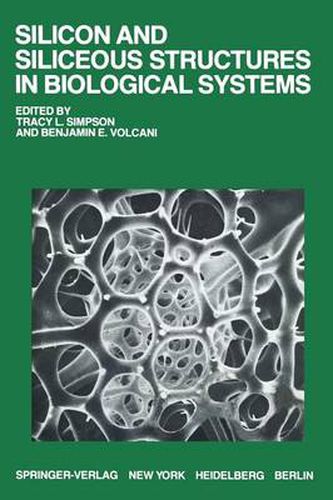Readings Newsletter
Become a Readings Member to make your shopping experience even easier.
Sign in or sign up for free!
You’re not far away from qualifying for FREE standard shipping within Australia
You’ve qualified for FREE standard shipping within Australia
The cart is loading…






This title is printed to order. This book may have been self-published. If so, we cannot guarantee the quality of the content. In the main most books will have gone through the editing process however some may not. We therefore suggest that you be aware of this before ordering this book. If in doubt check either the author or publisher’s details as we are unable to accept any returns unless they are faulty. Please contact us if you have any questions.
The publication of this book was undertaken with two purposes in view: to bring together informatian on the deposition by living organ isms of unique skeletal structures composed of amorphous silica, and to review recent data on the involvement of silicon in physiological and biochemical processes. Although widely varying viewpoints are represented, all the contributors are very interested in the events in volved in the formatian of siliceaus structures and their function. Data presented deal with these questions in a variety of plant and animal systems, and at levels ranging from the evolutionary to the biochemical and ultrastructural. Innovations in electron microscopy and, indeed, the advent of electron microscopy itself, have stimulated many ultra structural studies of silica deposition, work which has deepened and widened the interest in those organisms which routinely produce glassy skeletons.
The question of how silicon participates in biological systems in volves a spectrum of fields that indudes the chemistry of silicon per se, its biogeochemistry, biochemistry, ecology, and so forth. In this book, however, attention is focused up on the biological aspects of silicon and siliceous structures, with emphasis on the evolutian, phylogeny, morphology, and distribution of siliceaus structures, on the cellular as peets of silica deposition, and on the physiological and biochemical roles of silicon. This volume represents the first compilatian of such data. Because such a variety of subjects and fields are covered, the reader will have to glean for himself some of the comparative aspects of the data.
$9.00 standard shipping within Australia
FREE standard shipping within Australia for orders over $100.00
Express & International shipping calculated at checkout
This title is printed to order. This book may have been self-published. If so, we cannot guarantee the quality of the content. In the main most books will have gone through the editing process however some may not. We therefore suggest that you be aware of this before ordering this book. If in doubt check either the author or publisher’s details as we are unable to accept any returns unless they are faulty. Please contact us if you have any questions.
The publication of this book was undertaken with two purposes in view: to bring together informatian on the deposition by living organ isms of unique skeletal structures composed of amorphous silica, and to review recent data on the involvement of silicon in physiological and biochemical processes. Although widely varying viewpoints are represented, all the contributors are very interested in the events in volved in the formatian of siliceaus structures and their function. Data presented deal with these questions in a variety of plant and animal systems, and at levels ranging from the evolutionary to the biochemical and ultrastructural. Innovations in electron microscopy and, indeed, the advent of electron microscopy itself, have stimulated many ultra structural studies of silica deposition, work which has deepened and widened the interest in those organisms which routinely produce glassy skeletons.
The question of how silicon participates in biological systems in volves a spectrum of fields that indudes the chemistry of silicon per se, its biogeochemistry, biochemistry, ecology, and so forth. In this book, however, attention is focused up on the biological aspects of silicon and siliceous structures, with emphasis on the evolutian, phylogeny, morphology, and distribution of siliceaus structures, on the cellular as peets of silica deposition, and on the physiological and biochemical roles of silicon. This volume represents the first compilatian of such data. Because such a variety of subjects and fields are covered, the reader will have to glean for himself some of the comparative aspects of the data.